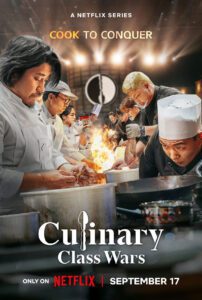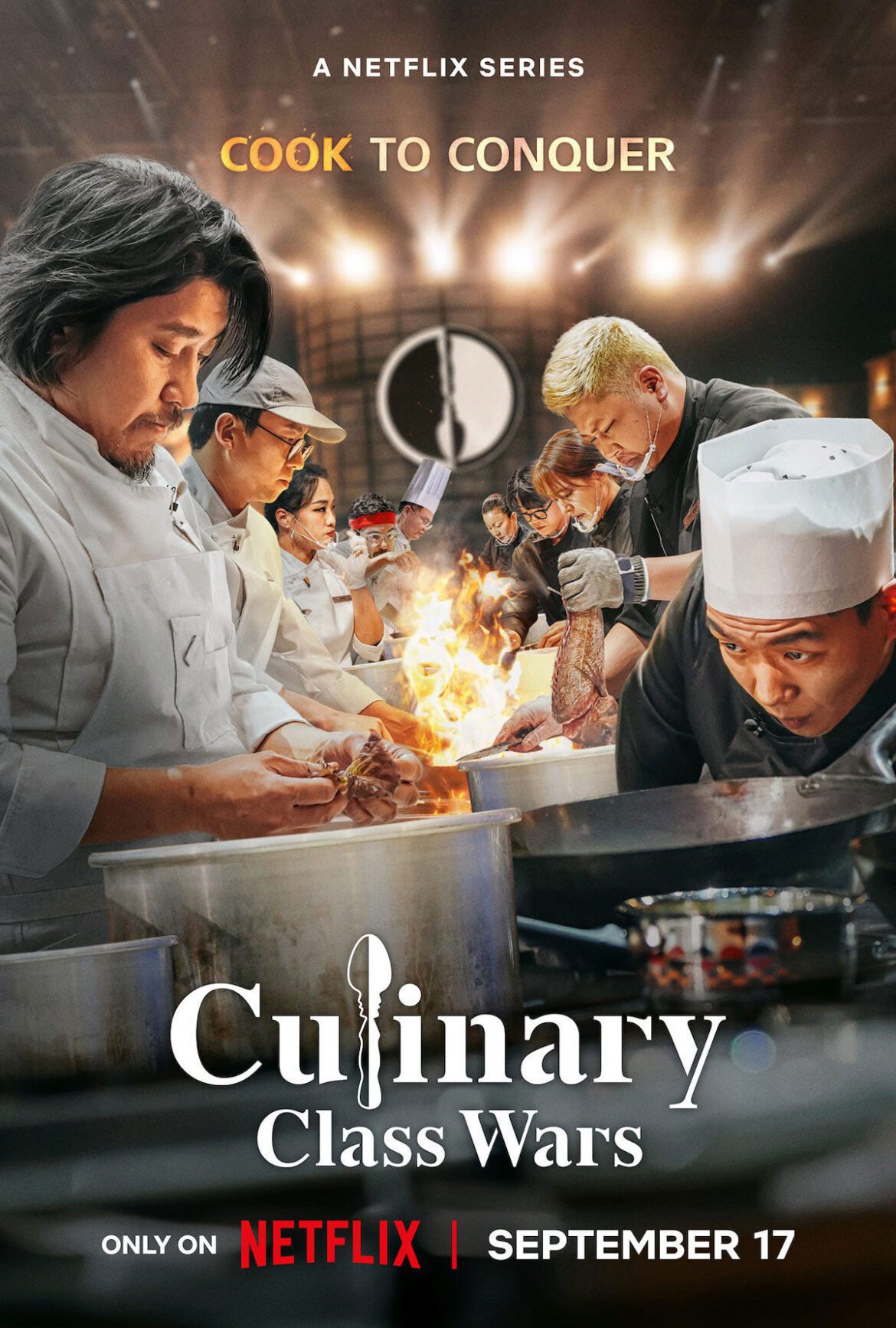
Service: Netflix
Season Year: 2024
Watch: Netflix
There is a lot of Korean TV viewed in this household. I’m not even talking about Squid Game. No, Hipster Jr. Jr. is a big K-pop fan and also watches K-dramas where girls turn into dogs and women turn into ice cream cones. And an autistic lawyer dreams of whales in Extraordinary Attorney Woo. But mostly it’s YouTube skits of giggly “idols” playing dumb games on overly-bright sets or the local mall. There is often an obsession with food in many of these videos and shows. The same way authors like Murakami (who I know is Japanese and not Korean) has this thing where he’s always describing what a character is making for lunch. I’ve had my share of Korean food over the years, but I’d hardly call myself an aficionado. Point being, there is a culinary tradition in Asia, and more specifically Korea, that is wholly different than the U.S., the home of many of the reality cooking competitions I’ve watched. So, growing bored with that crop, this one intrigued me. And, indeed, intrigued Hipster Jr. Jr.
What is American food? Burgers. Pizza. Hot dogs. Some sort of roasted or fried chicken. Mac ‘n’ cheese? Steak? But it’s also ethnic food and ethnic food mash-ups. Italian, Tex-Mex, Chinese. People in the U.S. have so many different cuisines at their fingertips, and most have made their way into the American diet on a regular basis. Is Chipotle American food? Hipster Jr. is like 1/3 Chipotle if his diet is any indication, and I have a hard time thinking of anything more popular with American teens. The thing you start to realize with Culinary Class Wars is that the average Korean citizen mostly just eats… Korean food. Even the chefs on the show — and we start with a staggering 100 chefs — seem to mostly cook and mostly consume food made with and featuring Korean ingredients and preparations. The food is just much more homogeneous. Which is evident when they all look around the room and separate out the “Western” chefs, Chinese and Japanese chefs. Western basically being anything that isn’t Asian food. And Chinese and Japanese basically just being food that is typically associated with those nations, but cooked almost exclusively by Koreans. There are a couple random white-guy contestants, but they’re outliers.
But, ultimately, most of the challenges included making food that generally used Korean ingredients — many chili pastes like gochujang — and also cooking things that might appeal to a Korean palate and a Korean audience. In other words, cooking stuff that would feel familiar to Koreans, whose tastes and appetites are used to certain dishes. It’s not Top Chef. where a chef with an African background cooks African food that might contain flavors not generally found in American cooking. Or a Dominican chef cooking a stew made of parts we’d generally throw away and with spices we don’t usually taste at the local steak joint. The American chef shows seem to go out of their way to find cuisines to expand the judge’s palates, to give them something they’ve never tasted or never thought to eat together. Because there is no “familiar” in American cuisine. And it’s this discovery that makes those shows interesting and exciting. Not so much with this show. But what they do have is that very narrow path to cooking good food and appealing to an audience they know might bristle against, say, an African porridge or a super-spicy South American dish.
Despite the overall samey-ness of a lot of the dishes, they were literally foreign to me. It wasn’t like this was a French show and everyone was making soufflés and coq au vin. Both delicious, but both things that I’m familiar with, with ingredients I know and understand. Korean cooking is filled with all sorts of oils and fermented things and even vegetables that are new and interesting. So, even if everyone seemed to use some version of a “jang,” and/or make their version of Chinese Dongpo pork or kimchi-jjigae, both are things I have never eaten, nor ever seen. But everyone on the show seemed to be very familiar with it all. The craziest contestant was a woman who cooked meals for school children. Literally a lunch lady. And she took such pride in her food, as she cooked giant vats of stuff that no god-fearing American child would touch with a ten-foot pole tipped with someone else’s mouth. And she made it through a couple rounds. My lunch lady they would have launched into space after defrosting a frozen chicken patty half way and sticking it on a white bun with a bag of Lay’s. Again, the culture of food is just so different there.
The other incredible thing is the sheer amount of food the two judges eat. There’s one guy who is a restaurateur and marketer, Paik Jong-won, who really looked at the food like a consumer would. Is this food the Korean public would like and buy? Which goes back to the whole Korean palate thing. The chefs had to take this into consideration. So, no like weirdo Icelandic fermented herring in a béchamel sauce or whatever. It had to be appealing specifically to a Korean audience in some way. And the other judge, Anh Sung-jae, is a three-star Michelin chef who was all about execution, clean taste and perfection. He actually immigrated to the U.S. as a young teen and opened his restaurant first in San Francisco with what sounds like a Korean fusion menu. He subsequently moved the restaurant to Seoul, but clearly maintains a more International palate and understanding of “Western” cooking. But, back to the gluttony. They ate so much. 100 contestants to start, and they tasted everything. And more and more in subsequent rounds. Paik would shovel food into his gob and sometimes take second heaping spoonfuls of people’s dishes for no other reason than he liked it and still seemed hungry after tasting 40 dishes. It was an act of sadism. To add, they had an episode where the judges were those mukbang YouTubers who pride themselves on eating insane amounts of food. A long table full of Joey Chestnuts. Or just nuts.
Ultimately, the show was a better deep dive into another country’s culture than it was a competition series. The mechanisms they employed to challenge the chefs felt a little Squid Game-ish. More strategy-meets-torture than creative cooking. And the judging also felt a bit arbitrary. But the contestants were so incredibly gracious and deferential to their peers, it felt foreign even beyond the food they were preparing. I don’t know if famous American chef, Ed Lee, was a plant to draw in an American audience, but it certainly worked on me. Shit, the dude worked at Chez Es Saada in NYC (probably while we sat on pillows drinking overpriced drinks) and is pretty much the Korean version of me (looks and age-wise only). His struggle to speak the language and his story about his duality as a Korean American was actually really emotional and fascinating. Even he, the winner of Iron Chef America, was humble and clearly thankful for the experience. The whole series and the mechanics around it is a little stilted, but, again, I think that’s a cultural thing. Regardless, it was interesting to see different cuisine get a lot of play, and I’m here for it.


